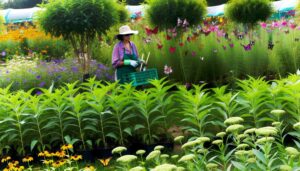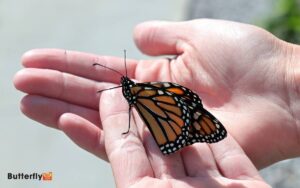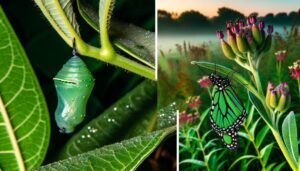3 Key Differences Between Monarch Butterfly Eggs Vs Aphids
Monarch butterfly eggs and aphids are distinct in appearance and impact on milkweed plants. Monarch eggs are ovate, pale creamy white, and have a ribbed texture, typically laid individually on the underside of milkweed leaves.
In contrast, aphids are small, soft-bodied insects ranging from 1 to 10 millimeters and often gather in clusters. While monarchs minimally deplete nutrients, aphids extract sap, leading to weakened growth and increased susceptibility to diseases.
Effective management strategies must consider the ecological roles and natural predators of both organisms, offering further insights into their interactions.
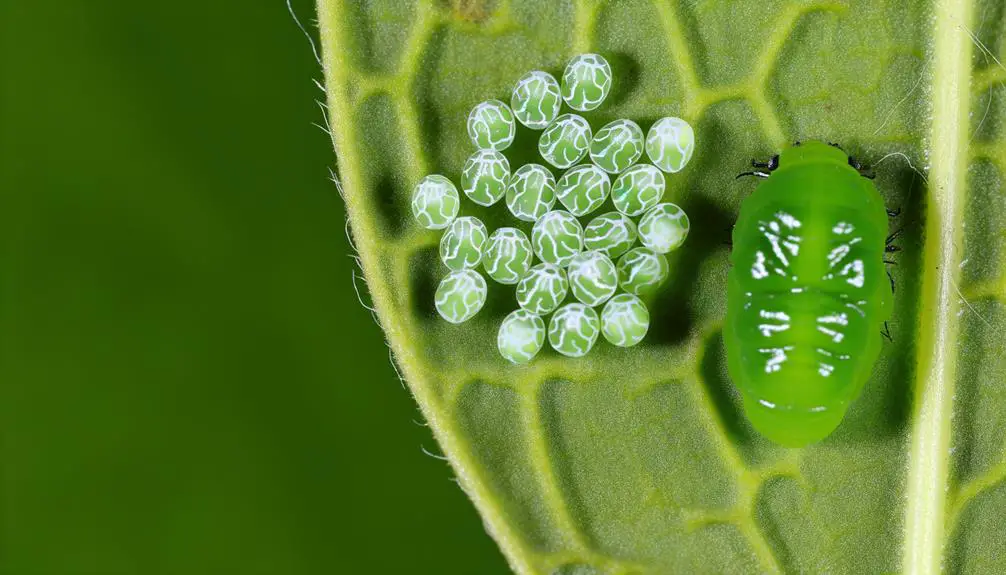
Key Takeaways
- Monarch butterfly eggs are ovate and creamy white with a ribbed texture, while aphids are soft-bodied and vary in color, including green, yellow, and black.
- Monarch eggs are typically laid on the underside of milkweed leaves, whereas aphids cluster on various plant leaves, extracting sap.
- Monarch eggs hatch into caterpillars within 3-5 days, while aphids reproduce rapidly asexually, leading to infestations.
- Aphids cause significant plant damage and nutrient depletion, whereas monarch egg impact on milkweed is low but larvae cause high leaf damage.
Monarch Butterfly Life Cycle
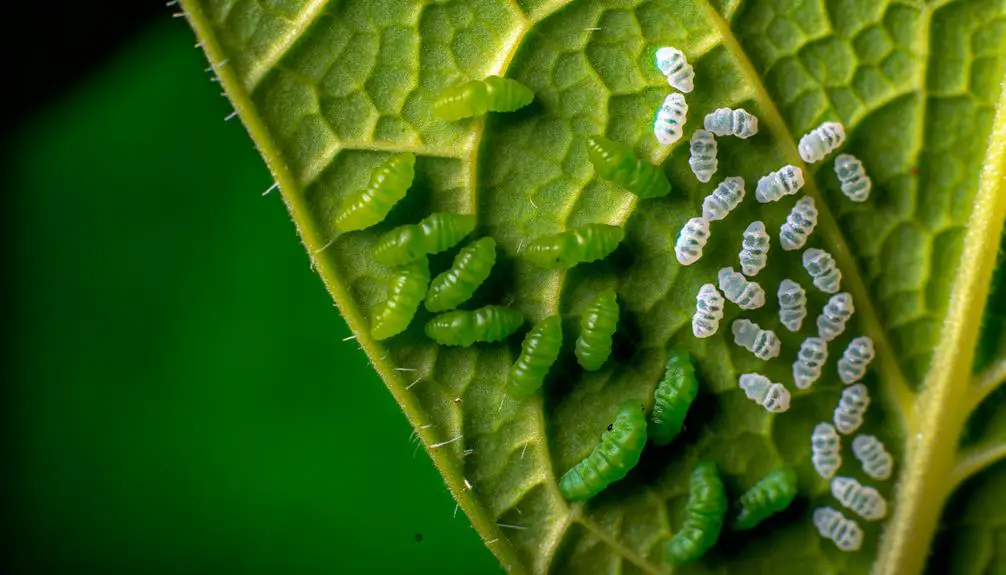
How does the intricate life cycle of the Monarch butterfly (Danaus plexippus) progress from a single egg to a fully mature adult, involving multiple developmental stages and critical biological processes?
The process begins with the female butterfly laying a single egg on the underside of a milkweed leaf. Within approximately 4 days, the egg hatches into a larva, or caterpillar.
This caterpillar undergoes five instars, molting between each stage as it consumes milkweed. After 10-14 days, the caterpillar forms a chrysalis, entering the pupal stage.
Inside the chrysalis, metamorphosis occurs, transforming the insect into an adult butterfly. After about 10 days, the adult butterfly emerges, ready to begin its lifecycle anew, showcasing remarkable biological and ecological adaptations.
Aphid Life Cycle
The life cycle of aphids, small sap-sucking insects belonging to the superfamily Aphidoidea, involves a complex process of parthenogenesis and sexual reproduction, varying greatly with environmental conditions.
During most of the year, aphids reproduce asexually through parthenogenesis, where females give birth to live nymphs without fertilization. These nymphs undergo several molts before reaching adulthood.
In response to seasonal changes, particularly the onset of winter, many aphid species switch to sexual reproduction. Males and females are produced, mate, and females lay fertilized eggs that can withstand harsh conditions.
These eggs hatch in spring, giving rise to a new generation.
Environmental factors such as temperature, photoperiod, and host plant quality greatly influence these reproductive strategies and life cycle dynamics.
Identifying Monarch Butterfly Eggs
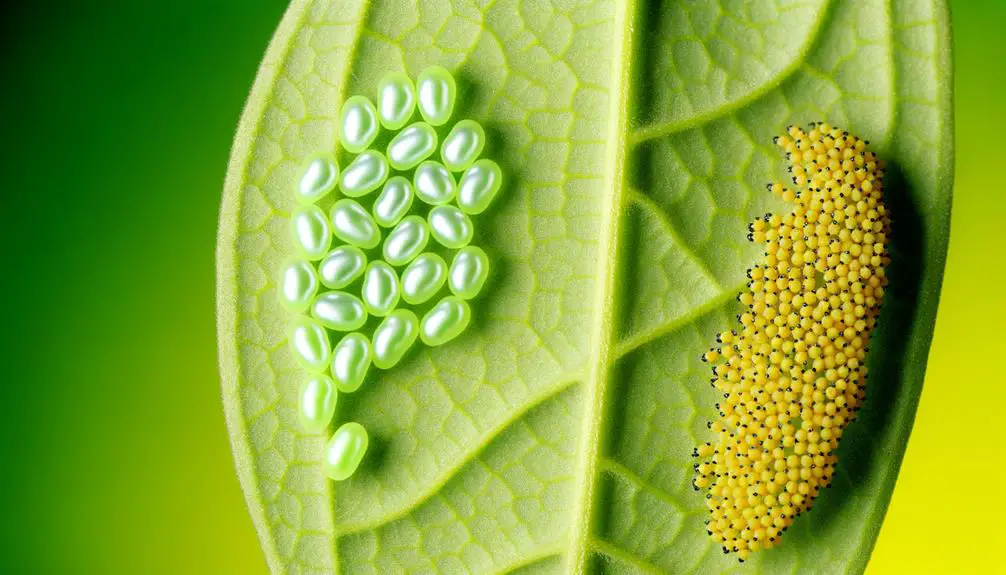
Monarch butterfly eggs are distinguishable by their ovate shape and pale creamy white color, typically deposited singly on the underside of milkweed leaves.
These eggs exhibit a characteristic ribbed texture, aiding in their identification.
The hatching timeframe generally spans 3 to 5 days, dependent on environmental conditions such as temperature and humidity.
Egg Shape and Color
Distinguished by their unique ovate shape and pale cream color, monarch butterfly eggs are typically laid singly on the underside of milkweed leaves. These eggs measure approximately 1.2 mm in length and are characterized by a ridged surface that aids in identification. The hue of the eggs ranges from white to a light yellow, which can subtly change as they approach hatching.
| Feature | Description |
|---|---|
| Shape | Ovate |
| Color | Pale cream to light yellow |
| Surface Texture | Ridged |
These specific attributes assist in differentiating monarch eggs from other insect species. The precise details of shape, color, and surface texture are essential for entomologists and conservationists in identifying and protecting these delicate stages of monarch development.
Plant Location Preference
Understanding the specific plant location preferences is fundamental for accurately identifying monarch butterfly eggs in their natural environment.
Monarch butterflies mainly lay their eggs on milkweed plants (genus Asclepias), which provide essential nutrients for larval development.
Female monarchs exhibit a preference for the underside of leaves, often selecting younger, tender foliage where egg viability is highest. This choice minimizes predation risks and maximizes access to fresh plant material.
Additionally, monarch eggs are typically found on plants situated in open, sunny habitats, as these conditions favor milkweed growth and subsequent larval success.
Identifying these precise habitats and plant characteristics is vital for distinguishing monarch eggs from those of other species and understanding their ecological interactions.
Hatching Timeframe
Determining the hatching timeframe of monarch butterfly eggs is essential for accurately identifying and studying their early developmental stages.
Monarch butterfly eggs typically hatch within 3 to 5 days post-oviposition, depending on ambient temperature and humidity levels. Warmer conditions tend to accelerate embryonic development, while cooler temperatures may prolong the hatching period.
Close observation reveals that the eggs shift from a creamy white to a darker hue as the larvae prepare to emerge. This coloration change is indicative of nearing hatching and can serve as a significant marker for researchers.
Precise knowledge of these timelines enhances our understanding of monarch lifecycle dynamics, aiding in effective conservation and study efforts. Understanding these parameters guarantees detailed, timely, and informed interventions.
Identifying Aphids
Identifying aphids requires attention to their appearance and size, as they are typically small, soft-bodied insects ranging from 1 to 10 millimeters in length.
These pests are commonly found in clusters on the undersides of leaves and stems, especially in temperate climates.
Their impact on plants includes the extraction of sap, leading to weakened growth and the potential transmission of plant viruses.
Appearance and Size
Aphids, typically ranging in size from 1 to 10 millimeters, exhibit soft-bodied, pear-shaped forms that facilitate their identification. Their coloration varies greatly, encompassing green, yellow, black, brown, and even pink hues, depending on the species and environmental factors.
Aphids possess two distinctive cornicles, or siphunculi, protruding from their posterior, which are often used in defensive secretions. The head features compound eyes and a set of antennae that are relatively long compared to their body.
These insects are also equipped with specialized mouthparts known as stylets, designed for piercing plant tissues and extracting sap. The detailed morphology of aphids, including their segmented bodies and minuscule appendages, underscores their adaptability and resilience in a variety of ecological niches.
Common Habitats
Commonly found in temperate regions, aphids thrive in diverse habitats including gardens, agricultural fields, and forested areas where host plants are abundant.
These small, sap-sucking insects are particularly prevalent in environments rich in herbaceous plants, shrubs, and trees.
Aphids exhibit a strong preference for new growth, where they can easily access the phloem sap, their primary food source.
They are often found clustered on the undersides of leaves, along stems, and in the crevices of buds.
Their adaptability allows them to colonize both wild and cultivated plants, making them ubiquitous in various ecosystems.
The presence of ants, which farm aphids for their honeydew, is also a common indicator of aphid infestations in these habitats.
Impact on Plants
The pervasive presence of aphids in various habitats can lead to significant detrimental effects on plants, necessitating accurate identification to manage infestations effectively.
Aphids, small sap-sucking insects, can be recognized by several key characteristics:
- Size and Color: Typically, aphids are 1-3 mm in size and vary in color from green to black, depending on the species.
- Antennae and Cornicles: Aphids possess long antennae and a pair of tube-like structures called cornicles protruding from their posterior, which are distinctive.
- Plant Damage: Look for signs such as yellowing leaves, stunted growth, and the presence of a sticky substance known as honeydew, which can lead to sooty mold formation.
Accurate identification is essential for implementing effective control measures, preserving plant health and ecosystem balance.
Monarch Butterfly Egg Placement
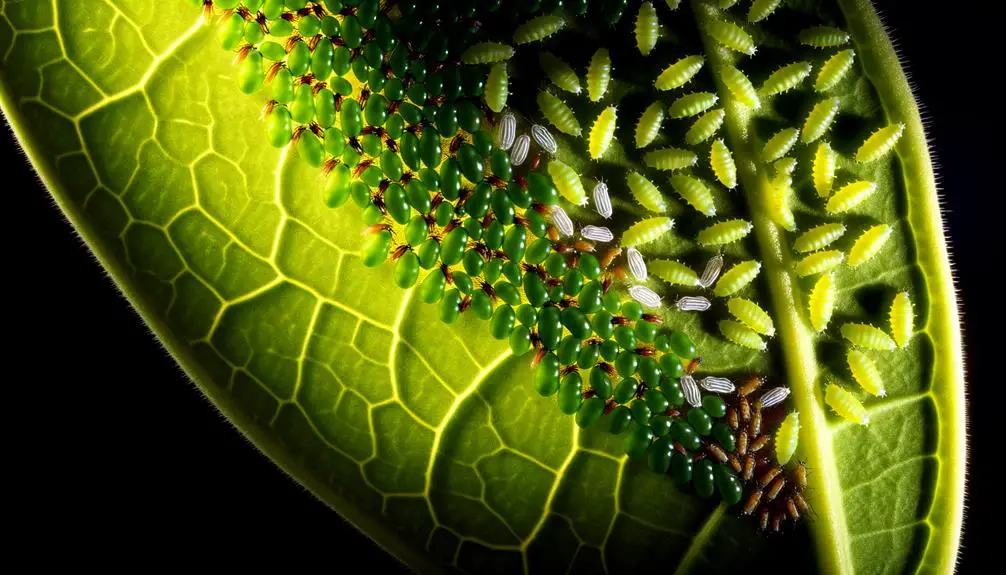
Monarch butterfly females strategically place their eggs on the underside of milkweed leaves, a behavior driven by the plant's availability of nutrients and its role in providing protection from predators.
This precise egg placement maximizes larval survival rates by ensuring immediate access to essential food sources upon hatching. Milkweed leaves not only offer a rich nutritional profile necessary for caterpillar development but also contain toxic compounds that deter many potential predators.
By selecting the underside of the leaves, female monarchs further shield their progeny from environmental hazards, such as harsh sunlight and rainfall, as well as from predatory insects and birds.
This intricate egg-placement strategy underscores the evolutionary adaptations monarchs have developed to optimize larval success and species propagation.
Aphid Colonization
Aphid colonization is characterized by their rapid reproduction rates, which can lead to significant infestations within a short period.
This proliferation often results in extensive plant damage due to their sap-feeding habits, weakening the host plants and potentially transmitting plant pathogens.
The role of natural predators, such as lady beetles and parasitic wasps, is essential in mitigating aphid populations and maintaining ecological balance.
Rapid Reproduction Rates
Exhibiting astonishing fecundity, aphids can rapidly colonize milkweed plants, outcompeting monarch butterfly eggs for resources and space. These small, sap-sucking insects display exceptional reproductive capabilities, enabling them to quickly establish large populations.
Key factors contributing to their rapid reproduction rates include:
- Asexual Reproduction: Many aphids reproduce parthenogenetically, giving birth to live young without mating, greatly accelerating population growth.
- Short Generation Time: Aphids can mature from nymph to adult in as little as one week under favorable conditions, allowing multiple generations within a single season.
- High Birth Rates: A single female aphid can produce dozens of offspring in her lifetime, exponentially increasing colony size.
This reproductive efficiency poses a considerable challenge for monarch butterfly conservation efforts.
Plant Damage Impact
Colonization by aphids inflicts significant damage on milkweed plants, primarily through the extraction of phloem sap, which depletes crucial nutrients and weakens overall plant health. The aphids' feeding activity disrupts the plant's physiological processes, leading to reduced growth, chlorosis, and increased susceptibility to pathogens. Additionally, aphid secretions, such as honeydew, promote the growth of sooty mold, further impairing photosynthesis.
| Impact | Description | Consequence |
|---|---|---|
| Nutrient Depletion | Loss of crucial nutrients | Reduced plant vigor |
| Chlorosis | Yellowing of leaves | Impaired photosynthesis |
| Stunted Growth | Inhibited elongation and expansion | Smaller plant size |
| Sooty Mold | Fungus growth on honeydew | Reduced light absorption |
| Pathogen Susceptibility | Increased disease vulnerability | Higher infection rates |
The cumulative effects of aphid colonization can severely compromise the ecological role of milkweed in supporting monarch butterflies.
Natural Predators' Role
The presence of natural predators, such as lady beetles, lacewings, and parasitic wasps, plays an essential role in mitigating the detrimental effects of aphid colonization on milkweed plants. These biological control agents contribute considerably to maintaining an ecological balance, thereby supporting the survival of monarch butterfly eggs.
- Lady Beetles: These beetles consume large quantities of aphids, effectively reducing their population.
- Lacewings: Lacewing larvae, also known as 'aphid lions,' are voracious predators of aphids.
- Parasitic Wasps: These wasps lay eggs inside aphids, leading to the eventual death of the host.
Impact on Milkweed Plants
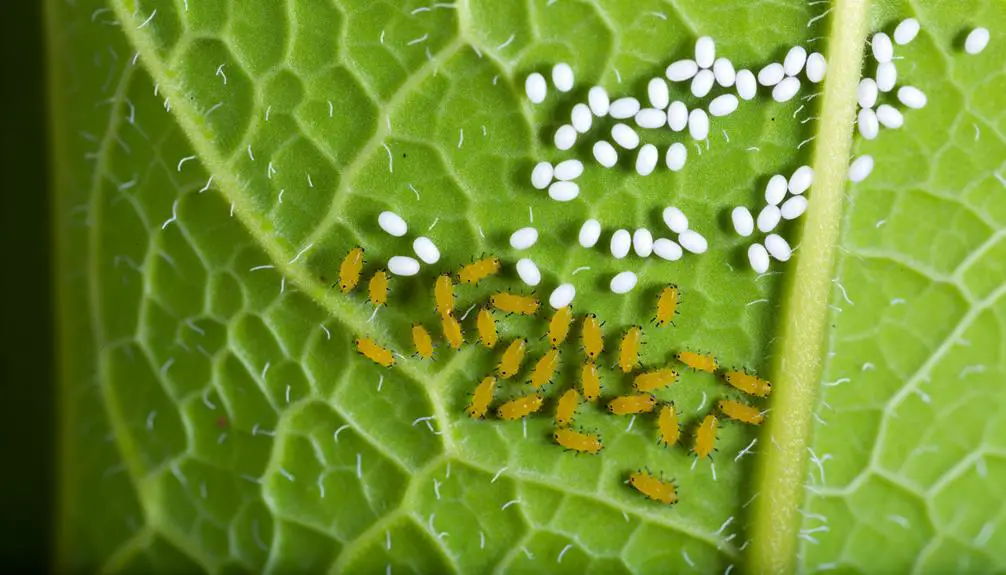
Infestation by aphids and the deposition of monarch butterfly eggs on milkweed plants can result in significant stress, affecting the plant's growth and overall health. Aphids extract crucial nutrients, while monarch larvae consume leaf tissue, further compromising the plant's vitality. This duality of stressors can lead to stunted growth, reduced flowering, and decreased seed production, thereby impacting the broader ecosystem that relies on milkweed.
| Impact Factor | Aphid Infestation | Monarch Eggs Deposition |
|---|---|---|
| Nutrient Depletion | High | Low |
| Leaf Damage | Moderate | High |
| Growth Impairment | Significant | Moderate |
| Flower Production | Reduced | Slightly Reduced |
| Ecosystem Disruption | High | Moderate |
This intricate balance underscores the necessity for careful ecosystem management to promote the health and sustainability of milkweed populations.
Aphid Damage to Plants
Aphid damage to plants manifests through the extraction of essential sap, leading to nutrient depletion and compromised plant physiology. These tiny pests pierce plant tissues with their specialized mouthparts, siphoning off crucial sugars and other nutrients.
The ramifications of aphid infestations are multifaceted:
- Stunted Growth: The continuous loss of sap inhibits normal growth and development, resulting in smaller, weaker plants.
- Sooty Mold Formation: Aphids excrete honeydew, a sugary substance that fosters the growth of sooty mold, which can impede photosynthesis.
- Virus Transmission: Aphids are vectors for numerous plant viruses, exacerbating plant health issues and potentially leading to widespread agricultural damage.
Understanding these damaging mechanisms is critical for devising effective management strategies against aphid infestations.
Beneficial Roles of Monarchs
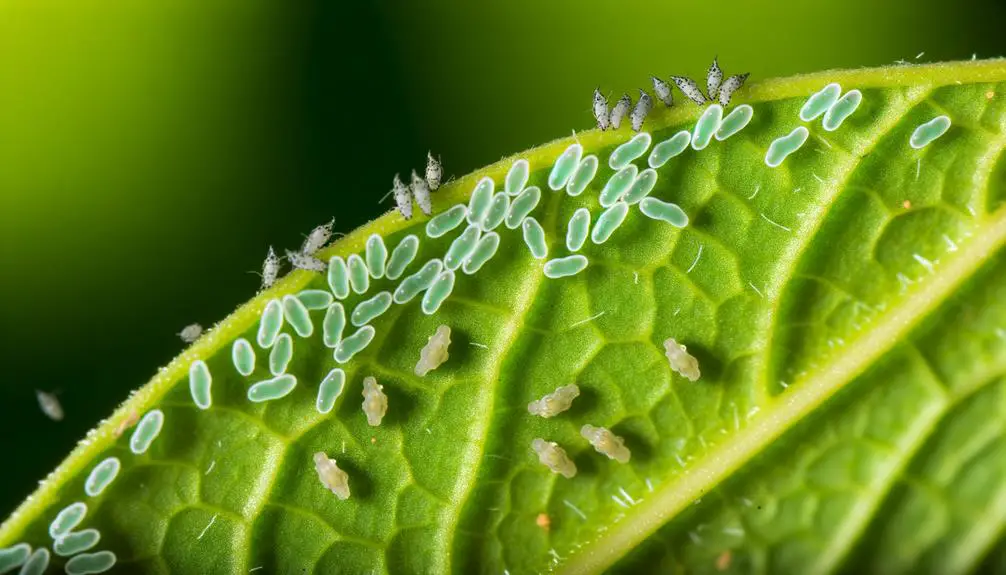
While aphids pose significant challenges to plant health, monarch butterflies contribute positively to ecosystems through their role in pollination and as indicators of environmental quality.
Monarchs facilitate the reproduction of various flowering plants by transferring pollen as they feed on nectar. This pollination process is vital for maintaining biodiversity and ecosystem stability.
Additionally, monarch populations serve as bioindicators, reflecting the health of their habitats. Their sensitivity to environmental changes, such as climate fluctuations and habitat loss, provides important data for ecological monitoring.
By supporting native plant species and contributing to ecological balance, monarchs play an indispensable role in sustaining the health and resilience of natural environments.
Consequently, their conservation is essential for ecological integrity.
Natural Aphid Predators
Natural aphid predators, such as lady beetles, lacewings, and parasitic wasps, play a crucial role in regulating aphid populations and maintaining the health of plant ecosystems. These predators exhibit distinct behaviors and life cycles that make them effective biological control agents.
Lady beetles, for example, consume numerous aphids daily, considerably reducing their numbers. Lacewings, in their larval stage, are voracious feeders, targeting aphid colonies.
- Lady Beetles: Consume up to 50 aphids per day, aiding in rapid population control.
- Lacewing Larvae: Known as 'aphid lions,' they can devour hundreds of aphids throughout their development.
- Parasitic Wasps: Lay eggs inside aphids, leading to their eventual demise as the larvae develop internally.
These predators guarantee a balanced ecosystem, promoting plant health.
Managing Aphid Infestations
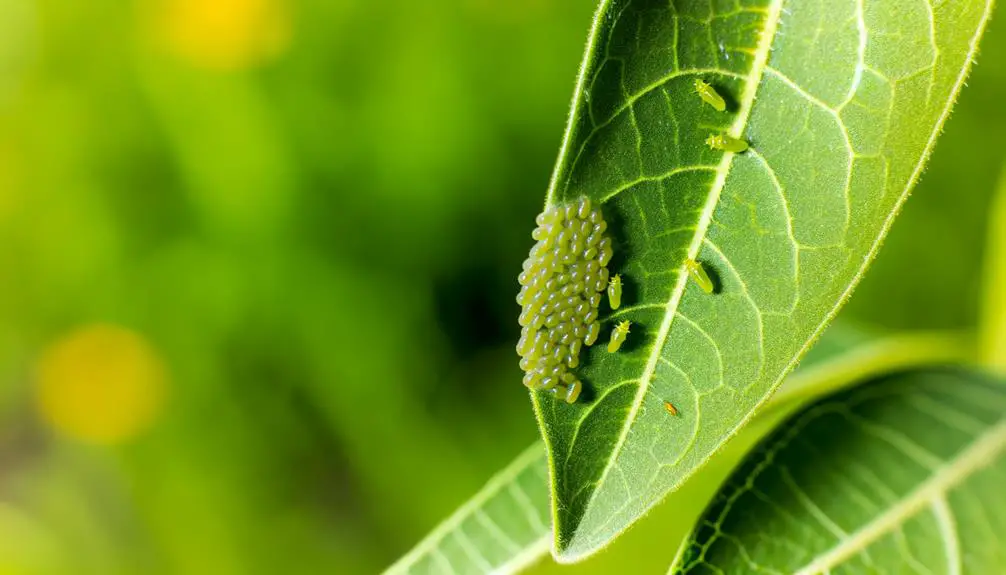
Understanding the role of natural predators is fundamental, yet integrating additional strategies is often necessary for effectively managing aphid infestations. Employing a multipronged approach enhances the efficacy of control measures while promoting ecological balance. Chemical treatments, though effective, should be used sparingly to avoid disrupting beneficial insect populations. Biological controls, such as introducing parasitoid wasps, provide sustainable alternatives. Additionally, cultural practices like crop rotation and intercropping can reduce aphid proliferation. For a thorough understanding, consider the following table detailing various management strategies:
| Strategy | Description |
|---|---|
| Chemical Treatments | Use of insecticides; risk of non-target effects |
| Biological Controls | Introduction of natural enemies; sustainable |
| Cultural Practices | Crop rotation, intercropping; reduces aphid habitat |
These methods collectively safeguard monarch habitats and guarantee long-term aphid control.
Conclusion
The coinciding life cycles of monarch butterflies and aphids highlight the intricate interactions within ecosystems.
Monarch butterfly eggs, often found on the undersides of milkweed leaves, signify the beginning of a metamorphic journey essential for pollination.
In contrast, aphids, which reproduce rapidly and damage plants, attract natural predators that contribute to ecological balance.
Understanding the identification, placement, and impacts of these two species underscores the complexity of managing agricultural landscapes while preserving beneficial insect populations.

